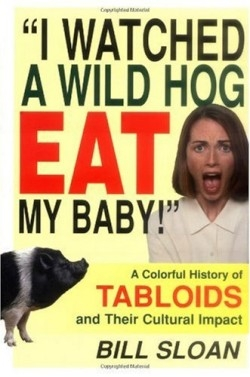I Watched a Wild Hog Eat My Baby
A Colorful History of the Tabloids and Their Cultural Impact
One day in the mid-1970s a group of tabloid writers and editors were drinking at a dingy Chicago bar. They worked for the National News Extra, the tabloid that on Dec. 8, 1974 published the headline that gave this book its title. They were trying to come up with a story with legs, one they could revisit time and again.
Someone suggested a story about a woman raped by an abominable snowman. There could be follow-up stories about her pregnancy and childbirth. When the monster child had grown to a hefty 70 or 80 pounds, he could go on a rampage, devouring animals at a local farm. The headline of the last story would be: “I watched a wild baby eat my hog!”
Sloan opens his tale of the tabloids with that anecdote—without a hint it might be apocryphal—because it illustrates the tabloid practice at the time, which was to write the headlines first and the stories later. In an age when mainstream newspapers often were gray and staid, the tabloids offered headlines like “B-52s found on the moon” and “Plastic surgeon’s goof gives man pelican bill.” The latter headline was accompanied by a doctored photo of a distraught man with a pelican bill.
Sloan, who once wrote for the now-defunct Dallas Herald Times, a mainstream newspaper, also labored in the management trenches at three tabloids, including the top dog of the industry, the National Enquirer. One of his points, and it is a disconcerting one from a certain point of view, is that the writers and editors of the tabloids often worked in the mainstream press at other times in their careers.
The author makes moral and ethical judgments only cryptically. He refers in passing to “the money-hungry photographers who helped kill” Princess Diana but does not dwell on the implications. Mainstream and tabloid journalism, even when they could be easily distinguished from each other, both had flaws, he suggests.
Some tabloid journalism easily qualified as burlesque. Many of the readers of the National News Extra were college kids who enjoyed its sheer goofiness. The Extra once ran a story about sex-crazed robots invading a California town. The story included an “eyewitness” account of a robot propositioning a gas pump, which it called Ethyl. The gas pump was not responsive, and the robot got angry: “Dammit, take your finger out of your ear and listen to me when I’m talking to you.”
Sloan traces the roots of the tabloids back to pre-printing press days, when crowds would flock to executions and traveling bards sang of murder and mayhem. In the early 1800s, publishers discovered the masses would gobble up cheap newspapers filled with lurid content about crime, fires, and disaster. A half century later, publisher Joseph Pulitzer’s yellow journalism took the same content to new extremes, going so far as to orchestrate the Spanish-American War.
The tabloids that rose up in the second half of the last century generally started by offering gory crime stories or sexual titillation. As supermarkets replaced corner stores, the tabloids had to clean up their acts in order to take their place in the checkout lines of middle America. Celebrity coverage became the industry’s bread and butter. The Kennedys, particularly Jackie, figured prominently, along with Hitler, Marilyn Monroe, and Elvis, and more recently Princess Diana and perhaps the most exploited murder victim in history, Jon Benet Ramsey.
The tabloids began as the brainchildren of blatantly avaricious but colorful, quirky, and creative personalities like National Enquirer founder Generoso Pope, with his rumored ties to the CIA and the Mafia, and Midnight co-founder, John Vader, who checked into a motel room as Elvis so he could publish stories about the ensuing sexual escapades.
Sloan estimates tabloids once had a combined readership of more than forty million. Today, faced with all kinds of competition, including competition from a mainstream press that previously ignored them, the tabloids are losing readers. All six of the surviving tabloids—the Enquirer, Star, Examiner, Weekly World News and Sun—are owned by the same company, American Media Inc.
Even as the tabloids continue to try to gain legitimacy, the mainstream media became more like the tabloids. The mass media, with its unrelenting stream of celebrities and sex, has undermined the role of the tabloids.
“We are living in a tabloid world,” says Lois Pope, widow of the Enquirer founder, as quoted by Sloan.
While tabloids might disappear, Sloan concludes that whatever the medium there will always be a following for “the shadowy underside of journalism, where fact and fantasy mingle and mate, where nothing is forbidden and where thrills and shudders are the only measure of success….”
Reviewed by
Rich Wertz
Disclosure: This article is not an endorsement, but a review. The publisher of this book provided free copies of the book to have their book reviewed by a professional reviewer. No fee was paid by the publisher for this review. Foreword Reviews only recommends books that we love. Foreword Magazine, Inc. is disclosing this in accordance with the Federal Trade Commission’s 16 CFR, Part 255.

